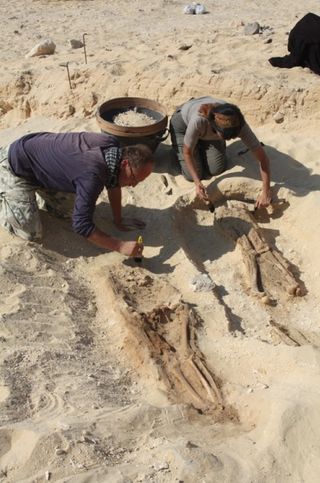
While an Egyptian pharaoh built majestic temples filled with sparkling treasures, the lower classes performed backbreaking work on meager diets, new evidence suggests.
An analysis of more than 150 skeletons from a 3,300-year-old cemetery at the ancient Egyptian city of Amarna reveals fractures, wear and tear from heavy lifting, and rampant malnutrition amongst the city's commoners.
The discovery, detailed in the March issue of the journal Antiquity, could shed light on how the non-elites of ancient Egyptian society lived.
Overnight city
For a brief, 17-year period, the center of Egypt was Amarna, a small city on the banks of the Nile, about 218 miles (350 kilometers) south of Cairo.
The pharaoh Akhenaten relocated his capital city to Amarna to build a pure, uncontaminated cult of worship dedicated to the sun god Aten. [Gallery: Sun Gods and Goddesses]
In a few years, temples, court buildings and housing complexes sprung up. At one time, 20,000 to 30,000 court officials, soldiers, builders and servants lived in the city.
Sign up for the Live Science daily newsletter now
Get the world’s most fascinating discoveries delivered straight to your inbox.
But after Akhenaten's death, the next pharaoh, Tutankhamun , promptly rolled up the experiment. The city, which lacked good agricultural land, was soon abandoned.
Because the Egyptians occupied Amarna for such a short time, the city provides archaeologists with an unprecedented insight into what people's lives looked like at a specific moment in history, said study co-author Anna Stevens, an archaeologist at the University of Cambridge.
Hard life
About 10 years ago, a surveyor investigating a region in the desert near Amarna discovered an ancient cemetery. The site contained hundreds of skeletons and skeletal fragments from lower-class Egyptians. [See Photos of the Ancient Egyptian Cemetery ]

To see what these everyday Egyptians' daily lives were like, Stevens and her colleagues analyzed 159 skeletons that were found mostly intact.
The researchers' conclusions: Life was hard at Amarna. The children had stunted growth, and many of the bones were porous due to nutritional deficiency, probably because the commoners lived on a diet of mostly bread and beer, Stevens told LiveScience.
More than three-quarters of the adults had degenerative joint disease, likely from hauling heavy loads, and about two-thirds of these adults had at least one broken bone.
The findings suggest that the rapid construction of Amarna may have been especially hard on the commoners. Based on the size of the bricks found in nearby structures, each worker likely carried a limestone brick weighing 154 pounds (70 kilograms) in assembly-line fashion. Erecting the city's structures so quickly would have required workers to repeatedly carry out such heavy lifting. That could have caused the joint disease the skeletons revealed.
The norm in Egypt?
"This is a fabulous study because it is a big population from a known site, and we have all these bodies from people who are relatively lower class," said Salima Ikram, an Egyptologist at American University in Cairo, who was not involved in the study.
But because, in total, archaeologists have unearthed so few ancient Egyptian cemeteries in which the non-elite were buried, it's possible that these backbreaking conditions prevailed across Egypt at the time, Stevens said.
Other research has found that even Egypt's wealthy suffered widespread malnutrition and disease, often living only to age 30.
Follow Tia Ghose on Twitter @tiaghose. Follow LiveScience @livescience, Facebook & Google+. Original article on LiveScience.com

Tia is the managing editor and was previously a senior writer for Live Science. Her work has appeared in Scientific American, Wired.com and other outlets. She holds a master's degree in bioengineering from the University of Washington, a graduate certificate in science writing from UC Santa Cruz and a bachelor's degree in mechanical engineering from the University of Texas at Austin. Tia was part of a team at the Milwaukee Journal Sentinel that published the Empty Cradles series on preterm births, which won multiple awards, including the 2012 Casey Medal for Meritorious Journalism.
